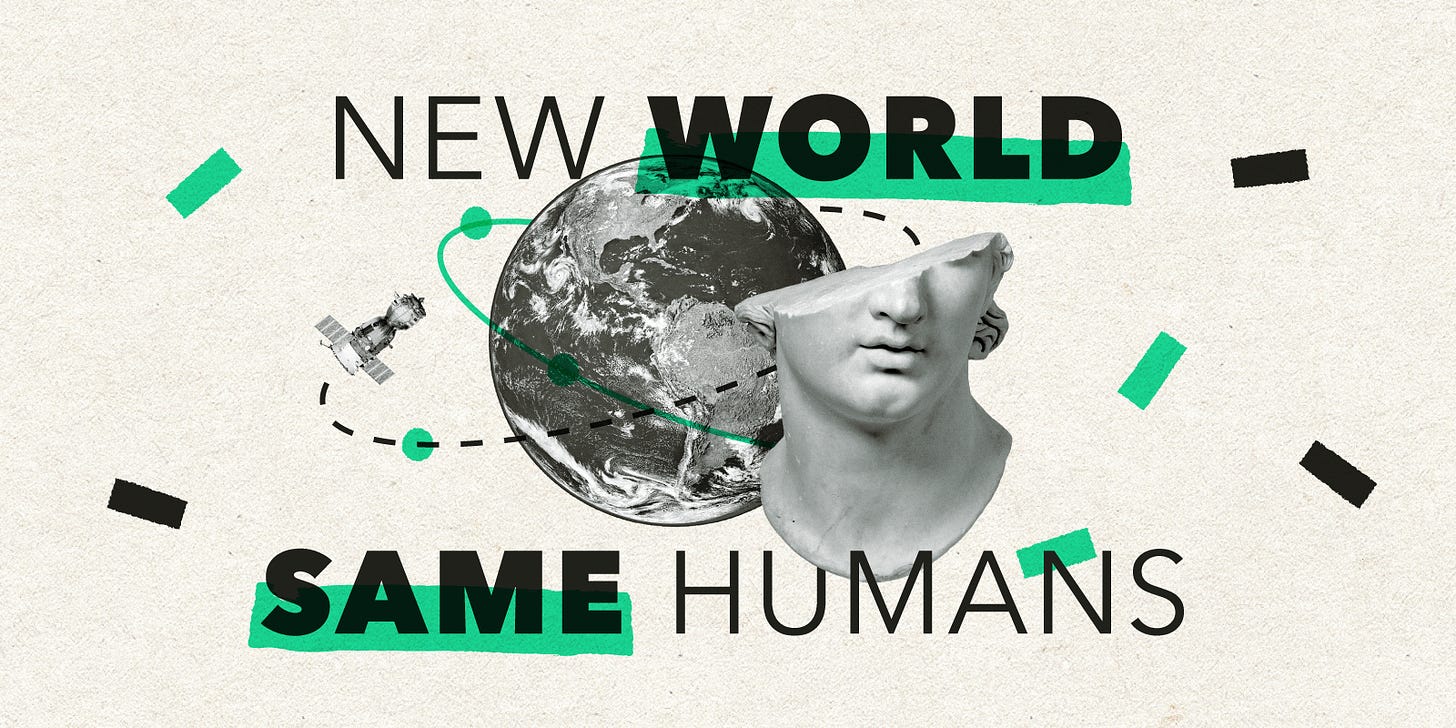New World Same Humans #12
Cities are key nodes in the world-network created by globalization. But is the Great Age of the City nearing its end?

Welcome to New World Same Humans, a weekly newsletter on trends, technology, and society by David Mattin.
It’s Easter weekend in London, and the streets are empty.
And it’s not just London; NYC, Rio, Sydney, Singapore – those great engines of human activity are temporarily stilled. At some point the lockdowns will end, and life will come roaring back. But I can’t help wondering if the pandemic will spark a change in our great cities, and the symbiotic relationship that the global elite have developed with them.
This week I pondered this Great Age of the City: how we got here, and where we’re heading next.
London calling to the faraway towns
The affluent world is three decades into a great urban boom. One that has taught its citizens to associate energy, creativity and ambition with cities. But those associations are not inevitable. It’s hard to imagine now, but back in the 1980s many were convinced that the age of the metropolis was over.
In 1985 the English novelist JG Ballard wrote:
'The future is going to be like a suburb of Dusseldorf. That is, one of those ultra-modern suburbs with the BMW and the boat in every drive...'
Ballard wrote innovative novels of the near-future that were prescient in many ways (check out the short story ‘The Intensive Care Unit’ for his vision of lives lived via webcam, pandemic-style). But when it came to the future of cities, he made a rare misstep. Like so many others at that time he believed that connective technologies and the rise of a new kind of knowledge worker would hollow out the inner cities permanently, and send the socio-economic centre of gravity to the suburbs. He even moved to a suburb himself, famously producing his strange and bracing novels from a very ordindary semi-detached in Shepperton, just outside the capital.
It’s easy to see why, back then, Ballard’s view was the mainstream one. By the mid-1970s London, NYC and other western megacities were deep in decline. The end of traditional industry had sent millions out of London; its population shrank by over a fifth, or 2 million people, between 1941 and 1992. In the 1980s NYC was famed not for its expensive apartments or Brooklyn hipsters but for its murders, which peaked at 2,500 in 1991 (in 2019 there were 300, and that was considered a bad year). The very words inner city became synonymous with decay.
But across the next three decades a new era restored the west’s cities to their status as key nodes in the world-network. That urban boom was shaped by powerful megatrends – globalization, financialization, the rise of knowledge work – and in turn did so much to shape the world we inhabit today. It’s a matter of more than incidental interest, for example, that while Ballard was writing in Shepperton, across the Atlantic an author of a quite different kind was placing his own bet on the future of the inner city. Donald Trump made his name via a series of bold plays on Manhattan real estate at a time when few others wanted to spend money on it. Trump used his rich father’s connections – and the desperation of NYC, which by the 1980s was close to bankruptcy – to acquire derelict buildings for next to nothing. When he bought the Commodore Hotel (now the Grand Hyatt) for $10 million in 1980 it was reportedly infested with rats. It's no exaggeration to say that the urban boom and the Trump presidency are closely related phenomena. For three decades Trump rode that boom only, in 2016, to put the social and economic polarization it had fuelled in the service of a new kind of American populism.
So first came the money, then came the bankers, then the service industries, next the ad execs and creatives, the struggling artists seeking cheap apartments in rising districts; cue a culture explosion, gentrification, artisan cafes, the hipster. Hey presto, a brownstone costs $4 million, and you can pay £8 for avocado on toast in east London districts where once even the police hesitated to tread. In 2015 the London population hit 8.6 million; the same as it was in 1939.

For a while, though, there have been signs that the long urban boom is coming to an end. Today, millions of educated young aspirants pour into cities every year. They seek the lifestyle of the infamous metropolitan liberal elite. They discover, instead, a reality that is cramped, precarious, and impossibly expensive. London’s recent graduates may secure the flashy job titles they crave, but many will find themselves jammed into dingy flatshares that eat most of their immobile salaries. As for buying your own place one day? Without help from rich parents, you can keep dreaming.
That reality is now visible in data that shows high and rising migration out of London. The UK’s Office for National Statistics say that in 2018, a record 340,500 people moved out of the city. Only immigration from abroad is maintaining a steady population in the UK capital. A similar story is playing out in NYC, L.A, and other major US cities.
Many thousands among those leaving are young professionals, and middle class families with young children. The practical reasons they give for the move are heard over and again: lower rents, more space, a garden, schools. But for many, leaving the capital is as much a psychological shift as a physical one. Multiple generations of graduates have absorbed the message that cities are where the action is when it comes to work, culture, and creativity. To leave is, then, an assertion that things can be otherwise; that the life they aspire to can be possible outside the white hot crucible of the metropolis. As rising numbers of young professionals choose to leave, that message only becomes more credible.
And now, the pandemic. For its young and educated precariat London has become an even more brutal place. A tiny flat with three housemates and no garden is one thing when the going is good; it’s another when the city is on lockdown. Ditto healthcare services stretched, even at the best of times, to breaking point. Unemployment is even less fun when your spending power is in direct competition with that of the financial services elite. Anonymous neighbours and no family in sight make all these hardships more difficult.
The capital was already seeing an exodus. It seems likely that amid this pause, thousands more young Londoners are now plotting their exit. So when it comes to London – and indeed NYC and other western megacities – are we at the end of a long Imperial Phase, and the start of something new?
In many ways this reversal would be welcome. London, for one, has for years hoovered up the UK’s talent, capital and energy in a way that’s fuelled startling regional inequality. And at risk of repeating Ballard’s mistake, it is true that new platforms mean geographically dispersed knowledge workers can collaborate effectively as never before.
But a middle-class flight from western cities would present challenges, too. Cities, with their densely packed populations, are more energy efficient. And whatever the power of online collaboration, evidence shows that throwing millions of clever young people together at close quarters produces an amazingly fruitful cauldron of ideas and innovation. Meanwhile, the global trend towards urbanisation won’t end: the UN forecasts that 2.5 billion people will pour into megacities in Asia and Africa between now and 2050. Powerful new engines of enterprise and innovation are taking shape, and many more are set to emerge.
If the legacy western liberal democracies are to compete, then, they may have to find ways to capture the benefits of megacities while allowing their inhabitants to avoid the downsides. In the UK, efforts to connect the smaller cities of the north of England – effectively making them part of a single urban super-area – are a good start.
As plenty have noted across the last few weeks, the idea that the pandemic will change everything is rife right now, and overdone. The powerful socio-economic forces that draw young, ambitious people to cities will still be present when lockdowns are lifted, and they’re not going away quickly. But as with so many issues in play at the moment, the question we should ask ourselves it is not so much about what will happen as what should – what we can make happen collectively if we try. How can we use this moment to provoke a constructive readjustment? The reimagining of the relationship between megacities and our economic and cultural elite would open up a window to address related issues. The rise of regional inequality. The elite vs the rest polarization that helped fuel the populist wave. The need to renew our sense of local community and neighbourliness, which I wrote about last week.
If we take action to rebalance our economic and cultural centres away from urban dominance, we may well look back on the pandemic as the moment that sparked a generational shift when it comes to our relationship to cities.
These issues are far from new. But whatever happens once urban lockdowns are lifted, here in London – and no doubt in cities around the world – they will seem more urgent than ever.
Isolation Mars
I've shared my thoughts on the future of cities. But what about yours? If you live in a city, are you thinking of leaving? Or is it impossible to imagine living anywhere else? Hit reply and let me know!
In the meantime, three quick snippets.
This person spent four months isolated in a NASA-funded simulation of Mars, and now she has advice on living through the corona-lockdown.
Apple and Google are collaborating on technology to alert you if you've recently been in contact with someone who has the virus.
This former security advisor to Barack Obama says we’ve been living in a post-9/11 era, and now it’s finally over.
Until next week
That's enough from me.
Wherever you are – city, town, your rich uncle's rural mansion – thanks for reading.
David.
P.S: Word on the street is that the brilliant Nikki Ritmeijer designed the illustrations in this email.


